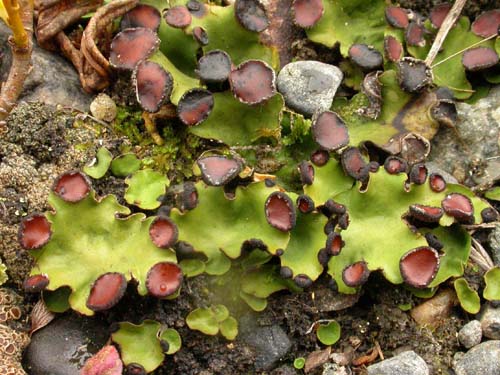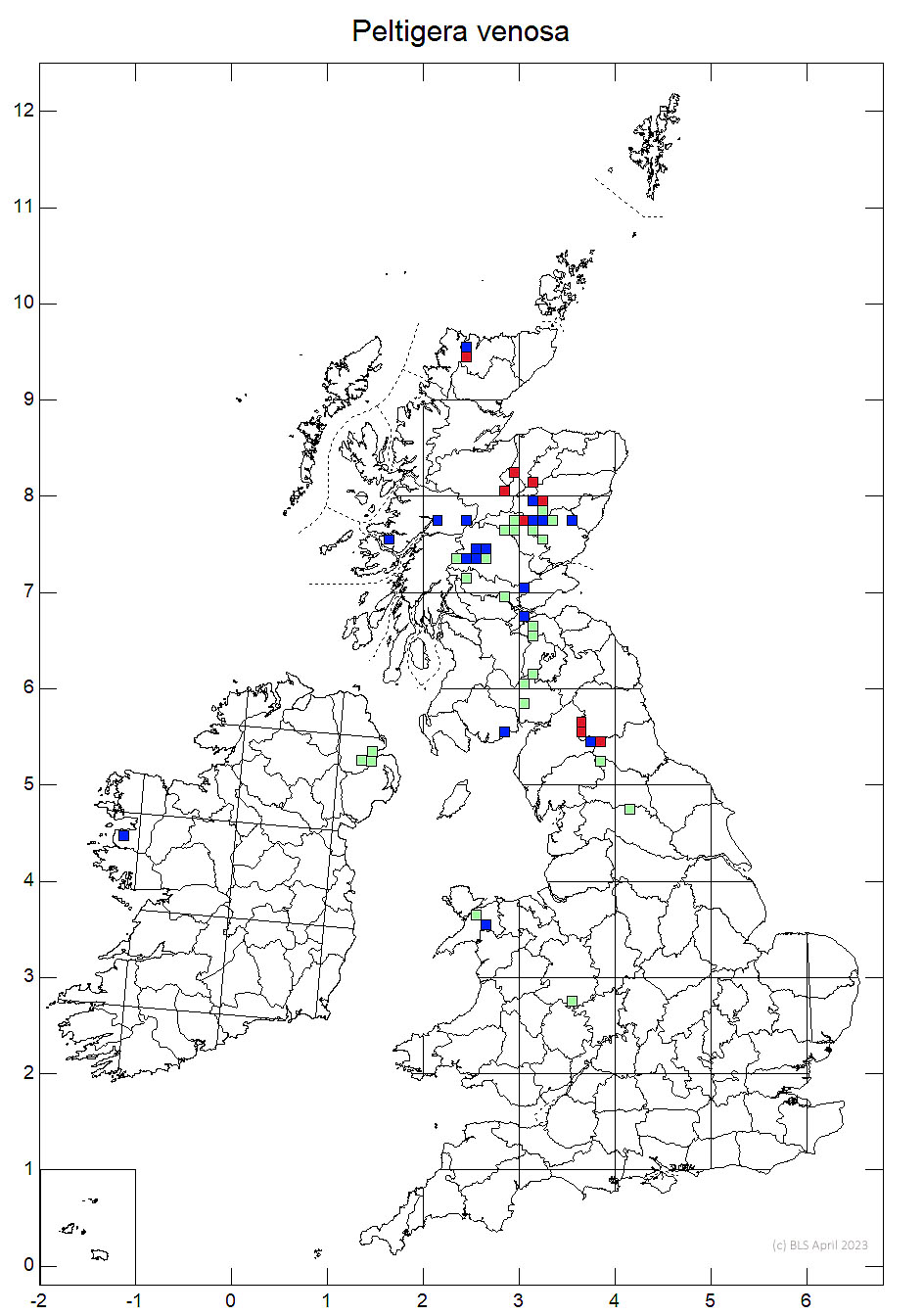Peltidea venosa (L.) Ach.
Pixie Gowns Lichen
 |
.jpg) |
| P. venosa upper surface. © E. Timdal. | Underside with veins and cephalodia. © E. Timdal. |
The green morphotype should be easily recognised by the small, neat lobes, bright green when fresh and wet. Peltigera britannica and P. leucophlebia are also green when fresh and wet, but they are much larger, with lobes 20-40 mm wide, and with the cephalodia occurring on the upper surface, where they are easily visible. Peltigera didactyla often has small thalli, but the upper surface is grey to grey-brown, the photobiont is Nostoc, the underside has pale veins and rhizines are present.
The blue-green morphotype is similar to very reduced forms of Leptogium species, including L. imbricatum and L. gelatinosum.
This mainly upland species is generally found on open, calcareous or metalliferous soils, rarely over limestone. The earliest Welsh record was said to be from base-rich flushes, the habitat of the other records was not specified.
Rare in the British Isles, with most records from the Central Highlands of Scotland, with scattered records in W and NW Scotland, S Scotland and N England. Recorded from two hectads in Eryri in Wales. Very rare in S England, with a nineteenth century record from Shropshire, and a 1967 record north-east of Swindon. Widespread in the northern hemisphere, mainly boreal and montane, but also recorded from lowland sites.
VC 49, 23/56: no locality or recorder, pre-1960.
VC 49, 23/65: Ogwen Valley, in base-rich flushes, 1840, John Ralfs (BM); det. O. Vitikainen.
VC 49, 23/65, Twll Du, July 1883, J.E. Griffith (NMW 27.76.131).
VC 49, 23/63.58: Glyder fawr, Twll Du, 1895, recorder unknown.
VC 49, 23/65: Llyn Llydaw, 1981, Tony Fletcher; blue-green morphotype, det. P.W. James.
The localised Welsh records are from a small area of Eryri, at altitudes over 430 m. The earliest record is poorly localised, and the cited locality 'Ogwen Valley' could be taken to include Twll Du.
The single Welsh specimen in NMW is from the herbarium of J.E. Griffith and probably collected by him. The green morphotype is apparently accompanied by the blue-green morphotype, though direct connections between the two are difficult to demonstrate. The specimen is accompanied by bryophytes including Amphidium mougeotii, Diplophyllum albicans, Herbertus stramineus, Pogonatum urnigerum, Racomitrium aciculare, and R. lanuginosum, and the vascular plant Silene acaulis (det. Tim Rich), consistent with a damp, open, base-rich habitat, perhaps a lightly flushed rocky bank.
Critically Endangered in Wales but Vulnerable and Nationally Scarce in Britain. This is a mainly upland species in the British Isles. Potential sites in Wales are likely to be those very local upland areas with calcareous influence. It is also likely that open conditions, with reduced competition from vascular plants, are necessary. The green morphotype of the species is a relatively conspicuous and easily recognised lichen, and is unlikely to have been widely overlooked, but the species could exist unrecognised as the blue-green morphotype.
Both morphotypes of the species should be looked out for in suitable habitats (calcareous flushes and banks with bare soil or rock) in Eryri. However, the lack of recent records and potentially large area to search may make specific surveys a poor investment of resources.
A study of the distinction between the blue-green morphotype and species of Leptogium would be useful to place records of the blue-green morphotype on a firm footing; such a study should use morphology, and if necessary, DNA sequencing.
UK BAP Actions 2008
- Conduct research to increase understanding of niche requirements for this species at UK and non-UK sites to better inform habitat management.
- Monitor habitat condition and species, at least every 6 years, at a subset of extant sites (e.g. those on designated sites) to ensure that the management maintains base rich upland rocks with current light, humidity and disturbance levels and modify accordingly.
Hitch, C.J.B., Fletcher, A., James, P.W. & Purvis, O.W. (2009) Peltigera Willd. (1787). In: The Lichens of Great Britain and Ireland (C.W. Smith, A. Aptroot, B.J. Coppins, A. Fletcher,O.L. Gilbert, P.W. James, & P.A. Wolseley, eds): 664-673. London: British Lichen Society
Ott, S. (1988) Photosymbiodemes and their development in Peltigen venosa. Lichenologist 20: 361-368.
- Log in to post comments

